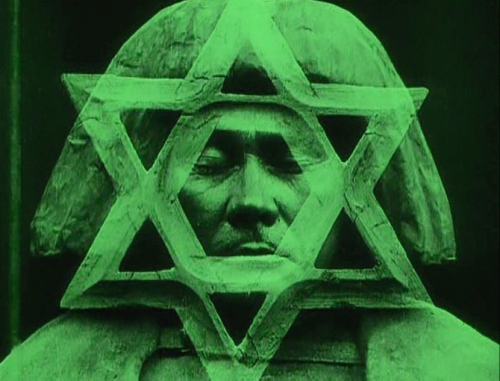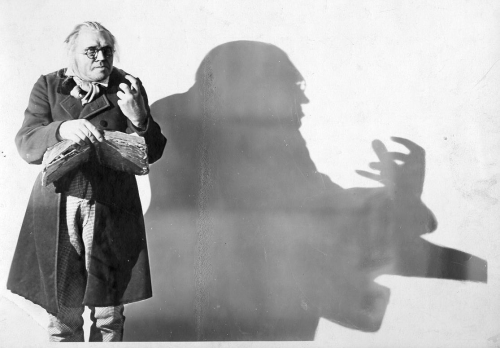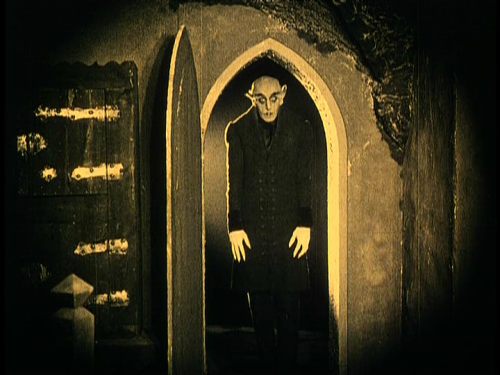“Masterworks” DVD set is imperfect, yet essential, viewing

In 1920s Germany, in the brief fertile years between World War I and Hitler’s reign, movies made the leap from entertainment to art.
German filmmakers of the silent era revolutionized the cinema of their time. Their influence is most obvious in what we know as the classic era of horror movies, particularly Universal horror movies of the 1930s, but traces of the German style are still easily identified in movies today.
Unfortunately, horror film fans, if they’re familiar with cinema history at all, are typically more aware of 1930s Hollywood films than their silent ancestors. Fans may be aware that German expressionist techniques were borrowed to create the atmosphere of Dracula (1931), Frankenstein (1931) and the monster films that followed. They may know that German emigrants who fled the Nazis were among the best talents behind the camera in Hollywood’s golden age, and nurtured film noir and science fiction films after World War II.
But it’s been a long time—a lifetime—since Germany’s own golden age, the era of The Golem (1920), The Cabinet of Dr. Caligari (1920) and Nosferatu (1922). These are arguably the three most important fantastic films of their time, and must viewing for serious horror aficionados.
The Golem is generally acknowledged as an influence on James Whale’s Frankenstein, and the parallels in some scenes are clear. The creation of the monster is here, though done through magic rather than pseudo-science; the charismatic monster turns on his maker in a satisfying fashion; an edgy encounter with a little girl leads to the monster’s undoing. The story is based on Jewish folklore, concerning a clay statue brought to life by a Rabbi Loew to save a community. Actor-director Paul Wegener played the Golem twice before in short films, and his practiced presence is effective here, as is the use of cock-eyed architectural sets representing a dream version of the Prague ghetto. Current sensibilities may be put off by the characterization of Jewish faith as a magical cult, but at least Jews are portrayed as sympathetic. The film’s portrayal of the Jew as a mysterious “other” might be seen as an attitude that evolved into Nazi bigotry in later years.

Robert Wiene’s Caligari is hailed as the first fully Expressionist film, immersing the viewer in its unsettling mood by use of twisted visuals and quirky acting. In the story told by an evidently insane narrator, prototypical mad doctor Caligari controls a somnambulist, Cesare (portrayed by prototypical horror star Conrad Veidt), and sends his hypnotized slave on missions of murder. Most striking to viewers today are the bizarre sets, created by a team led by Hermann Warm; in its day, the implications of this departure from realism were profound. The idea that a film, particularly a horror film, can draw the viewer into a world of its own was revolutionary then, and pervasive today. This disc also includes the only known footage from Wiene’s next macabre film, Genuine, a vampire tale.
Nosferatu is probably the easiest of the three films for current audiences to appreciate, because it’s based on the familiar tale of Dracula. Here the story is simplified, multiple characters are conflated into a few and renamed, the resolution is provided by a woman’s sacrifice rather than a stake-wielding posse, but the borrowing from Bram Stoker’s original is unmistakable. In fact, this film ran afoul of copyright considerations, and Stoker’s widow attempted to have most copies destroyed. We’re lucky it survived, because director F.W. Murnau’s storytelling is still strong, with creepy employment of special effects, and Max Schreck is still unmatched in his portrayal of the vampire as part man, part vermin, part supernatural force.

These are masterworks, but Elite’s two-disk set, “The Masterworks of the German Horror Cinema,” is not the superior presentation that these films deserve. That’s not really the fault of Elite, which has been a good friend to horror movie collectors going back to the laserdisc era. In this case Elite and the National Film Museum went looking for the best, or at least the earliest, 35mm source material, and did a no-frills transfer to disk. The stated rationale was to put the set on the market for an affordable price—extensive restoration would cost the company millions and drive the price out of sight for average collectors.
In the case of The Golem, this means a completely silent presentation, without the typical music track. Viewing a truly silent film takes some mental adjustment. But then, the music track for Nosferatu has a jarring electronic sound and is sometimes comically inappropriate; you’d be better off muting this film too and using a Philip Glass album for accompaniment.
According to packaging notes, Caligari and Nosferatu were transferred from copies that had musical soundtracks, Caligari from two “original” negatives and Nosferatu from a positive print found in German archives. Because these sources had soundtracks, the films play at sound speed, 24 frames per second, instead of the original silent speed of about 18 frames per second. That doesn’t hurt Caligari so much, because it has a rather stately pace anyway, but portions of Nosferatu have a staccato look. The unnatural speed makes Alexander Granach’s mannered performance as Jonathon (Harker) Hutter seem manic, particularly in the early scenes; this may be the only time you’ll see a vampire’s victim appear more sane after he’s bitten.
Picture quality is mediocre for all three films. The Golem and Caligari are contrasty and lack sharpness, while Nosferatu is plagued by dust, scratches and missing frames. (My VHS copy of Caligari is actually more detailed than the DVD.) Originally, prints of Caligari and Nosferatu were tinted in various colors to enhance the mood, but the tinting is not reproduced here. More troubling is the apparent resizing of the frame in Caligari and Nosferatu—in each film, the top of the frame appears to be cut off (surely this is a problem with the source material, not Elite’s transfer). The overall effect is akin to a screening at a student film society of the 1970s, before videotape and the rise of film restoration.
Image Entertainment has already issued two of the three titles in this set on DVD—Nosferatu and Caligari—in digitally remastered versions, with optional audio commentary by film historians. I don’t have access to these versions, but presumably the source material was not as original as the material used for this Elite collector’s set. The Golem is not available elsewhere on DVD. So, while we wait for some angel of a horror fan to invest in the further restoration of these classics, we’ll make do with this set.
DVD released in February, 2000.
Two-disk set with The Golem (68 minutes), Caligari (51 minutes) and Nosferatu (64 minutes).
Extras include a useful 10-page booklet of liner notes by Miroslaw Lipinski.
Suggested retail price is $54.95.
